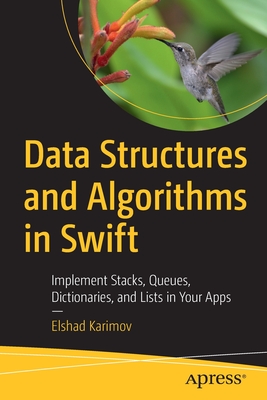Swift Data Structure and Algorithms
暫譯: Swift 資料結構與演算法
Erik Azar, Mario Eguiluz Alebicto
- 出版商: Packt Publishing
- 出版日期: 2016-11-21
- 售價: $1,650
- 貴賓價: 9.5 折 $1,568
- 語言: 英文
- 頁數: 286
- 裝訂: Paperback
- ISBN: 1785884506
- ISBN-13: 9781785884504
-
相關分類:
Algorithms-data-structures
海外代購書籍(需單獨結帳)
買這商品的人也買了...
-
 微積分學習要訣, 20/e (適用: 研究所.轉學考.大專用書)
微積分學習要訣, 20/e (適用: 研究所.轉學考.大專用書)$780$741 -
 大話設計模式
大話設計模式$620$490 -
 電腦視覺-演算法與應用 (Computer Vision: Algorithms and Applications)
電腦視覺-演算法與應用 (Computer Vision: Algorithms and Applications)$834$792 -
 白話大數據與機器學習
白話大數據與機器學習$480$379 -
 iOS 11 Programming Fundamentals with Swift: Swift, Xcode, and Cocoa Basics (Paperback)
iOS 11 Programming Fundamentals with Swift: Swift, Xcode, and Cocoa Basics (Paperback)$1,950$1,853 -
 忍者:JavaScript 開發技巧探秘, 2/e (Secrets of the JavaScript Ninja, 2/e)
忍者:JavaScript 開發技巧探秘, 2/e (Secrets of the JavaScript Ninja, 2/e)$650$507 -
 實戰封包分析|使用 Wireshark, 3/e (支援IPv6與Wifi) (Practical Packet Analysis: Using Wireshark to Solve Real-World Network Problems, 3/e)
實戰封包分析|使用 Wireshark, 3/e (支援IPv6與Wifi) (Practical Packet Analysis: Using Wireshark to Solve Real-World Network Problems, 3/e)$520$411 -
 Python 3.x 程式語言特訓教材
Python 3.x 程式語言特訓教材$490$387 -
 從零開始!邁向數據分析 SQL 資料庫語法入門
從零開始!邁向數據分析 SQL 資料庫語法入門$520$411 -
 $658Flask Web 開發實戰:入門、進階與原理解析
$658Flask Web 開發實戰:入門、進階與原理解析 -
 工程數學 (精要版)
工程數學 (精要版)$550$523 -
 $709Redis 使用手冊
$709Redis 使用手冊 -
 $534超大流量分佈式系統架構解決方案:人人都是架構師2.0
$534超大流量分佈式系統架構解決方案:人人都是架構師2.0 -
 $454Go語言高併發與微服務實戰
$454Go語言高併發與微服務實戰 -
 依賴注入:原理、實作與設計模式 (Dependency Injection: Principles, Practices, Patterns, 2/e)
依賴注入:原理、實作與設計模式 (Dependency Injection: Principles, Practices, Patterns, 2/e)$1,000$780 -
 大話 AWS 雲端架構:雲端應用架構圖解輕鬆學
大話 AWS 雲端架構:雲端應用架構圖解輕鬆學$550$429 -
 提升程式設計師的面試力|189道面試題目與解答, 6/e (修訂版) (Cracking the Coding Interview : 189 Programming Questions and Solutions, 6/e)
提升程式設計師的面試力|189道面試題目與解答, 6/e (修訂版) (Cracking the Coding Interview : 189 Programming Questions and Solutions, 6/e)$980$774 -
 白話演算法!培養程式設計的邏輯思考 (Grokking Algorithms: An illustrated guide for programmers and other curious people)
白話演算法!培養程式設計的邏輯思考 (Grokking Algorithms: An illustrated guide for programmers and other curious people)$520$468 -
 Python 刷題鍛鍊班:老手都刷過的 50 道程式題, 求職面試最給力 (Python Workout: 50 ten-minute exercises)
Python 刷題鍛鍊班:老手都刷過的 50 道程式題, 求職面試最給力 (Python Workout: 50 ten-minute exercises)$480$408 -
 巨型服務架構:分布式/資料庫優化/記憶體快取設計/IO模型
巨型服務架構:分布式/資料庫優化/記憶體快取設計/IO模型$690$545 -
 $607Go 語言高級開發與實戰
$607Go 語言高級開發與實戰 -
 Linux 指令大全:工程師活用命令列技巧的常備工具書 (全新升級版) (The Linux Command Line : A Complete Introduction, 2/e)
Linux 指令大全:工程師活用命令列技巧的常備工具書 (全新升級版) (The Linux Command Line : A Complete Introduction, 2/e)$780$608 -
 專技高考 -- 職業衛生技師歷屆考題彙編, 2/e
專技高考 -- 職業衛生技師歷屆考題彙編, 2/e$550$435 -
 可觀測性工程|達成卓越營運 (Observability Engineering: Achieving Production Excellence)
可觀測性工程|達成卓越營運 (Observability Engineering: Achieving Production Excellence)$680$537 -
 Terraform 建置與執行, 3/e (Terraform: Up and Running: Writing Infrastructure as Code, 3/e)
Terraform 建置與執行, 3/e (Terraform: Up and Running: Writing Infrastructure as Code, 3/e)$780$616
商品描述
Master the most common algorithms and data structures, and learn how to implement them efficiently using the most up-to-date features of Swift 3
About This Book
- Develop a deep understanding of the collections in the Swift Standard Library with this step-by-step guide
- Develop native Swift data structures and algorithms for use in mobile, desktop, and server-based applications
- Learn about performance efficiency between different data structures and algorithms
Who This Book Is For
This book is for developers who want to learn how to implement and use common data structures and algorithms natively in Swift. Whether you are a self-taught developer without a formal technical background or you have a degree in Computer Science, this book will provide with the knowledge you need to develop advanced data structures and algorithms in Swift using the latest language features.
What You Will Learn
- Get to know about the basic data structures and how to use the Swift REPL
- Use the Swift Standard Library collections bridging to Objective-C collections, and find out about protocol-oriented programming
- Find out about Swift generators and sequences, and see how to use them to implement advanced data structures such as Stack, StackList, Queue, and LinkedList
- Implement sorting algorithms such as Insertion Sort, Merge Sort, and Quick Sort and understand the performance trade-offs between them
- See how to implement various binary trees, B-Tree, and Splay Trees
- Perform advanced searching methods using Red-Black trees, AVL trees, and Trie trees, and take a look at several substring search algorithms
- Get to know about the data structures used in graphs and how to implement graphs such as depth-first search, breadth-first search, directed graphs, spanning tree, and shortest path
- Explore algorithm efficiency and see how to measure it
In Detail
Apple’s Swift language has expressive features that are familiar to those working with modern functional languages, but also provides backward support for Objective-C and Apple’s legacy frameworks. These features are attracting many new developers to start creating applications for OS X and iOS using Swift.
Designing an application to scale while processing large amounts of data or provide fast and efficient searching can be complex, especially running on mobile devices with limited memory and bandwidth. Learning about best practices and knowing how to select the best data structure and algorithm in Swift is crucial to the success of your application and will help ensure your application is a success. That’s what this book will teach you.
Starting at the beginning, this book will cover the basic data structures and Swift types, and introduce asymptotic analysis. You’ll learn about the standard library collections and bridging between Swift and Objective-C collections. You will see how to implement advanced data structures, sort algorithms, work with trees, advanced searching methods, use graphs, and performance and algorithm efficiency. You’ll also see how to choose the perfect algorithm for your problem.
Style and approach
This easy-to-follow yet comprehensive guide can either be read from beginning to end, or depending on your current knowledge level, you can jump to the specific chapter that interests you. Each chapter topic starts with an introduction to the topic and algorithm before moving on to the hands-on implementation and analysis.
商品描述(中文翻譯)
掌握最常見的演算法和資料結構,並學習如何使用 Swift 3 的最新功能有效地實現它們
關於本書
- 通過這本逐步指南,深入了解 Swift 標準庫中的集合
- 開發原生 Swift 資料結構和演算法,以用於移動、桌面和伺服器應用程式
- 了解不同資料結構和演算法之間的性能效率
本書適合誰
本書適合希望學習如何在 Swift 中原生實現和使用常見資料結構和演算法的開發者。無論您是沒有正式技術背景的自學開發者,還是擁有計算機科學學位的專業人士,本書都將提供您所需的知識,以使用最新的語言特性在 Swift 中開發先進的資料結構和演算法。
您將學到什麼
- 了解基本資料結構以及如何使用 Swift REPL
- 使用 Swift 標準庫集合與 Objective-C 集合之間的橋接,並了解協議導向編程
- 了解 Swift 生成器和序列,並查看如何使用它們來實現先進的資料結構,如 Stack、StackList、Queue 和 LinkedList
- 實現排序演算法,如插入排序、合併排序和快速排序,並理解它們之間的性能權衡
- 查看如何實現各種二元樹、B-樹和伸展樹
- 使用紅黑樹、AVL 樹和 Trie 樹執行先進的搜尋方法,並了解幾種子字串搜尋演算法
- 了解圖中使用的資料結構以及如何實現圖,如深度優先搜尋、廣度優先搜尋、有向圖、生成樹和最短路徑
- 探索演算法效率並了解如何測量它
詳細內容
Apple 的 Swift 語言具有表達性特徵,對於使用現代函數式語言的人來說非常熟悉,但也提供對 Objective-C 和 Apple 遺留框架的向後支持。這些特徵吸引了許多新開發者開始使用 Swift 為 OS X 和 iOS 創建應用程式。
設計一個能夠擴展的應用程式,同時處理大量數據或提供快速高效的搜尋可能是複雜的,特別是在內存和帶寬有限的移動設備上運行。了解最佳實踐並知道如何在 Swift 中選擇最佳資料結構和演算法對於應用程式的成功至關重要,並將幫助確保您的應用程式取得成功。這正是本書將教給您的內容。
從頭開始,本書將涵蓋基本資料結構和 Swift 類型,並介紹漸進分析。您將了解標準庫集合以及 Swift 和 Objective-C 集合之間的橋接。您將看到如何實現先進的資料結構、排序演算法、處理樹、先進的搜尋方法、使用圖形以及性能和演算法效率。您還將看到如何為您的問題選擇完美的演算法。
風格與方法
這本易於理解但內容全面的指南可以從頭到尾閱讀,或者根據您當前的知識水平,跳到您感興趣的特定章節。每個章節主題都以對主題和演算法的介紹開始,然後進入實作和分析。






























